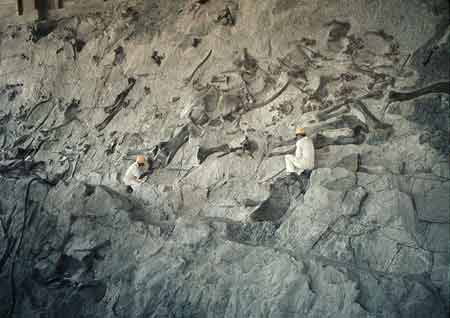Friday, September 15, 2017
Ammonites, Allosaurs and Sauropods. Oh, My.
(Picture from here.)
It has been a while since I put up a post-- nearly two months. A lot of things have happened in that time, including a two week vacation for the eclipse and a visit to Dinosaur National Monument.
There's been enough discussion of the eclipse that anything I can say about it is probably redundant. People have asked me what I thought. I have said, "It's an hour and a half of, hey, that's really interesting, followed by a minute and a half of transcendental ecstasy."
But enough of that. Except to say if you get a chance to go to a total eclipse or the monument, don't even think about it. Just go. The difference between totality and 99.999% totality is, literally, night and day.
Instead, I'm going to talk about what we did with the rest of the vacation: rocks and fossils.
Steamboat Springs was the center of our operations. From here we went north to Casper to see the eclipse but hung around Chalk Mountain in the afternoon looking for interesting rock. This is what we do: go some place and look at interesting rocks.
Chalk Mountain is a very strange place. It has land of the normal color surrounding a mountain made chiefly of black and white. It's like a strange composite photograph. There we found jasper and olivine. Ben found a single piece of turquoise the size of the tip of my little finger. No crystal material to speak of but some fossils. Nothing terribly identifiable but interesting none the less.
Here I want to talk about the Bureau of Land Management, one of my favorite parts of the federal government.
The feds own a lot of land. Some of it is of obvious use: parks, wildlife refuges, etc. But the vast majority the feds just hold in trust. They let cattle graze on it for a nominal fee. Sometimes they let miners use. Mostly, they just leave it alone.
This is not to say the public can't use the land. The public can and does. We have driven over hundreds of miles of BLM land, collecting minerals and fossils, looking at the views, taking pictures of the wildlife, watching the stars miles from any city.
There is some controversy about the BLM. It administers about 1/8 of the land of the country. There are a lot of people who don't believe in public ownership of any land much less that much. I'm not one of them. The whole idea of sequestering land for future possible use means that the land must be sequestered: not developed. Not reapportioned. Not sold.
The land within a particular state is administered by that state's BLM office and the rules change from jurisdiction to jurisdiction. We've explored land in Nevada, Utah, Wyoming and Colorado. The rules are significantly different between states. Some states allow collecting of petrified wood. Others do not. Nationally, you can't collect vertebrates without a permit but this is somewhat elastic in that no state has a limit on collecting shark's teeth and sharks are definitely vertebrates.
Anyway, so we collected on BLM land in Wyoming, looking for jasper and agates and found a few. Nice stuff that I might tumble.
Tuesday, we went to Dinosaur National Monument. (And here.) This place is like the eclipse: if you get a chance, go. Don't wait. Don't think about it. Go.
No rock or fossil collecting is allowed in any national park. But that's fine. We went to see the dinosaurs.
Picture from here.
Way back in 1909, the dinosaur fossil beds were discovered by Earl Douglass working for the Carnegie Museum. There were three rough pinnacles and they excavated down, exposing one bed after another.
Eventually, they decided (and possibly lost funding) that they had excavated enough. The bed reflected what looks like a massive death of dinosaurs from a flood. In 1915, Woodrow Wilson declared it a national monument. When he did so, a whole wall remained unexcavated. It is still unexcavated. But the entire wall is housed. It's about 70 feet long and about forty or so feet tall: a solid wall of dinosaur bones. Stegosaurus. Apatosaurus. Allosaurus. All right there for you to just observe.
Which we did for about three hours.
Afterwards, we drove across Echo Park Road, which is not for the squeamish. It was only chance that we ended up with a 4wd vehicle. At one point I looked down and there was a chunk of road missing beyond which was a 90 foot drop. Supposedly, it's one way but we met a Honda Fit coming the other way later in the trip. I have no idea how they navigated the road.
One should question one's mortality every good trip.
(Picture from here.)
The next day we went from the big vertebrates to the big invertebrates. We explored the ammonite locality in Kremmling, Colorado. (Also, see here.) Ammonites are extinct molluscs that resemble nautilus.
That vaguely spiral shape in the picture is about two feet across. It's the imprint a the ammonite shell. The Kremmling site has the largest fossil ammonites in the world.
This is a protected site with a fence all around it. But it is surround by BLM land. So we walked around the edge of the site but safely on BLM land and found a few good fossils to take home. The rules say we can take a small amount (a 5 gallon pail's worth) which is far less than what we collected. Thank you, BLM.
(For a really good artistic perspective of ammonites, see "Night of the Ammonites" by Ray Troll and can be purchased here.)
This is a wonderful country and there are wonderful things in it. Turns out 1/8 of them are on BLM land.
Subscribe to:
Post Comments (Atom)






No comments:
Post a Comment